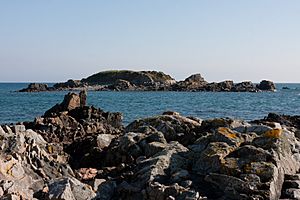La Motte, Jersey facts for kids

The islet in 2012
|
|
| Alternative name | Green Island |
|---|---|
| Location | Vingtaine de Samarès, Jersey |
| Coordinates | 49°09′38″N 02°04′38″W / 49.16056°N 2.07722°W |
La Motte, also called Green Island, is a special tidal island located off the coast of Jersey in the Channel Islands. It's a famous archaeological site, meaning it holds clues about people who lived there long ago.
People have visited this small island since the Neolithic period, which was a very long time ago. They left behind interesting things like a cairn (a pile of stones), middens (ancient trash heaps), and cists (stone burial boxes). These were found in the early 1900s. The island rises about 17 meters (56 feet) above the sea. You can only reach it when the tide is low, as the water covers the path twice a day. The island's rock formed during the late Pleistocene Ice Age and is covered by a type of soil called loess.
Where is La Motte?
This small island is about 200 meters (656 feet) from the main beach. It stands about 17 meters (56 feet) above sea level. The top of the island is covered in grass, and it's mostly made of clay surrounded by rocks.
To help protect the island from the ocean, people have built walls and steps. Remember, you can only walk to La Motte when the tide is out. When the sea comes in, the island becomes completely surrounded by water.
Discovering the Past
Many interesting archaeological finds have been made on La Motte. Experts believe that some remains of a cemetery belong to people who settled there later.
There are also signs from the Neolithic period, which was around 1500 BC to 300 BC. These include a cairn, which is a mound of stones, and several middens. Midden are like ancient garbage dumps, showing what people ate and used.
Eighteen cists, which are stone boxes used for burials, were found here. These were carefully dug up between 1911 and 1914. Today, you can see them at the La Hougue Bie museum.
The Island's Rocks
The area around La Motte, including the beach, was named a "site of special scientific interest" in 2009. This means it's important for studying science.
The rocks here were formed during the late Pleistocene period. They are covered with a preserved layer of loess, which is a type of fine soil. These layers of rock and soil help scientists understand how the environment changed a long time ago.
Gallery
See also
 In Spanish: La Motte (Jersey) para niños
In Spanish: La Motte (Jersey) para niños




